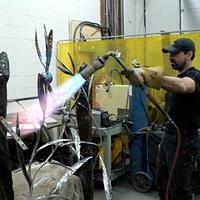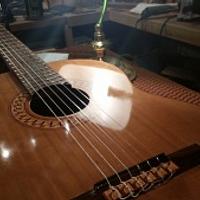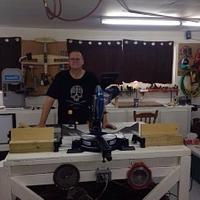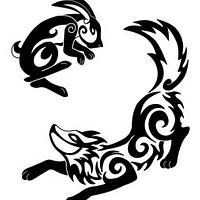
WestCoast Arts
in almost 11 years
guitars
Hey everyone,
Anyone have any experience making guitars?
I have a client interested in a carved bass guitar. I was thinking to buy a high end neck/fret board and make the body (mostly to be cost effective but also because I don’t really want to re-invent the wheel so to speak) but not sure… Maybe I’m better off doing all of the components?
This a new area for me so looking for any tips/suggestions. Anything I should be looking out for (especially in the joinery work around the neck/body).
It seems fairly basic but I know that instruments can be touchy things to build.
Cheers!
Angellos
18 Replies
Also…am I better off doing the frets/neck etc as well?
Angellos
if you’re experienced enough to carve then i think your only only issue is accuracy, make and draw a plan and stick to it. neck and body joins have to be exact. the best place to start is things like what hardware the guitar has, this will give you information about the height of the saddle position off the body and thus the neck angle. id also consider buying woods from a tonewood supplier as they will be able to give you advice about which woods to go for and can provide you with cuts for fingerboards etc. they will also be able to provide you with a lot of good information regarding building. frets are the most difficult bit in my opinion, and it’d be much easier to buy components and just assemble it but you wont have as much fun and the results wont be as good..
id recommend “Building Electric Guitars” by Martin Koch as a good bit of reading material, it focuses more on electric guitars and i think would be more relevant to you. i look forward to seeing the results.
Fitz
I play guitar you have to make it right or it want tune all aspect has to be true
jim
Accuracy shouldn’t be a problem. Thanks for the info, I’ll look for that book!
Thanks Jim, I’ve been drumming for about 35 years and have been around enough guitars to know the frustration of a cheaply made one! Drums are similar but much more forgiving.. lol
Angellos
I have made over thirty electric style guitars, most from scratch. A good place to use for a reference for materials is Luthers mercantile limited. http://www.lmii.com getting started with a kit then carving is probably what your wanting to do. An inexpensive place to purchase an electric kit with every component thought out for you is Do it yourself guitars http://diyguitarkits.net you can buy a kit then do your carving on the materials then assemble knowing the components are all there in one package. Most of all have fun doing it! I can’t wait to see what you come up with.
CHRIS, Charlottetown PEI Canada. Anytime you can repurpose, reuse, or recycle, everyone wins!
I’ve just started my adventures in stringed instruments and let me say that frets are tricky but could you honestly say you built a guitar if you didn’t do the trickiest bit? It’s fun. Have as much fun as you can.
-- Alec (Friends call me Wolf, no idea why)
good luck
jim
Thanks… still in designing/quoting stage the it is still up in the air
Angellos
A couple of decisions you will need to make, 1) scale, their are different scales used in fret placement. The two major types are fender and Gibson. 2) their are two different joinery options for attaching the neck, bolt on or, set thru. Each of these decisions has an effect on sound, look, playability, hardware, and the overall appeal to players. Ie; some players will only play on a Gibson scale but could care less about how the neck is connected, but want a very radical curve in the neck profile. When making a custom instrument for someone I usually ask what they are playing now and why, this will give you overall design decisions then you can get creative with various components from their. I hope this helps.
CHRIS, Charlottetown PEI Canada. Anytime you can repurpose, reuse, or recycle, everyone wins!
Yes it does, thanks Thorreain.
Angellos
make sure you have a neck with a truss rod in it this will keep the neck straight you can ajust a bolt on better than a fix neck a electric guitar is usely 22 frets scale
jim
For scales, The fender is 25-1/2" and the Gibson is 24-3/4". Each uses different types of hardware to hold the strings. All guitar necks contain truss rods, weather set thru or bolt on. The type that I install most are dual rods. The set thru neck is a stronger joint, but you can buy complete bolt on necks very cheaply, they also diminish the sound quality somewhat. Once again it’s up to the clients preferences.
CHRIS, Charlottetown PEI Canada. Anytime you can repurpose, reuse, or recycle, everyone wins!
Bass guitar scales are; 30", known as short scale and 34". which is average for a 4 or 5 string bass. There are also fanned fret multi-scales, but you don’t want to begin there. The scale length is determined by measuring from the fretboard side of the nut to the center line of the saddles. The twelfth fret is the octave, half or center of the scale length. Choosing well seasoned and stable material is imperative for neck construction and quarter sawn is preferred. Laminating the neck blank can add not just a decorative quality, but lends itself to stability. Double acting truss rods and/or carbon fiber rods are common. A truss rod allows for neck adjustment against string tension and wood movement. A scarf joint to produce the headstock is my preferred method. As for connecting the neck to the body blank, there are three common methods: 1.) bolt on neck: a neck pocket routed into the body blank and the neck is attached with screws or bolts through a neck plate or with ferrules
2.) Set neck, where a tenon is formed on the body end of the neck and the body blank is routed to accept the tenon, which is then glued in. 3.) Neck through is where the neck is the entire length of the instrument and the body “wings” are glued onto the sides of the neck. If you’ve never built an entire guitar, I’d recommend buying an already fretted neck, which ever type your client prefers, then you can slab out the body blank according to the scale length chosen, as you’ll want to design your carve around the bridge and pickup(s) placement. I’d also recommend viewing numerous videos on youtube to gain familiarity with the overall considerations of guitar building.
MikeMangini
Thank you everyone, great advice…exactly what I was hoping for
Angellos
Just a wee note on that ^^ (all good info btw) scale length is measured from the nut or zero fret to the centre of the 12th fret, you then double that measurement. The length between the nut and saddle is actually the scale length +2-3mm in order to correct the intonation for the height of the strings. It’s important to include that in the design or else you’ll never be able to move e saddles enough to correct the intonation.
Fitz
true
jim
Very interesting information ,lots of super posts.
woodworking classes, custom furniture maker
Most importantly have fun and try to post some pics along the way.
CHRIS, Charlottetown PEI Canada. Anytime you can repurpose, reuse, or recycle, everyone wins!














